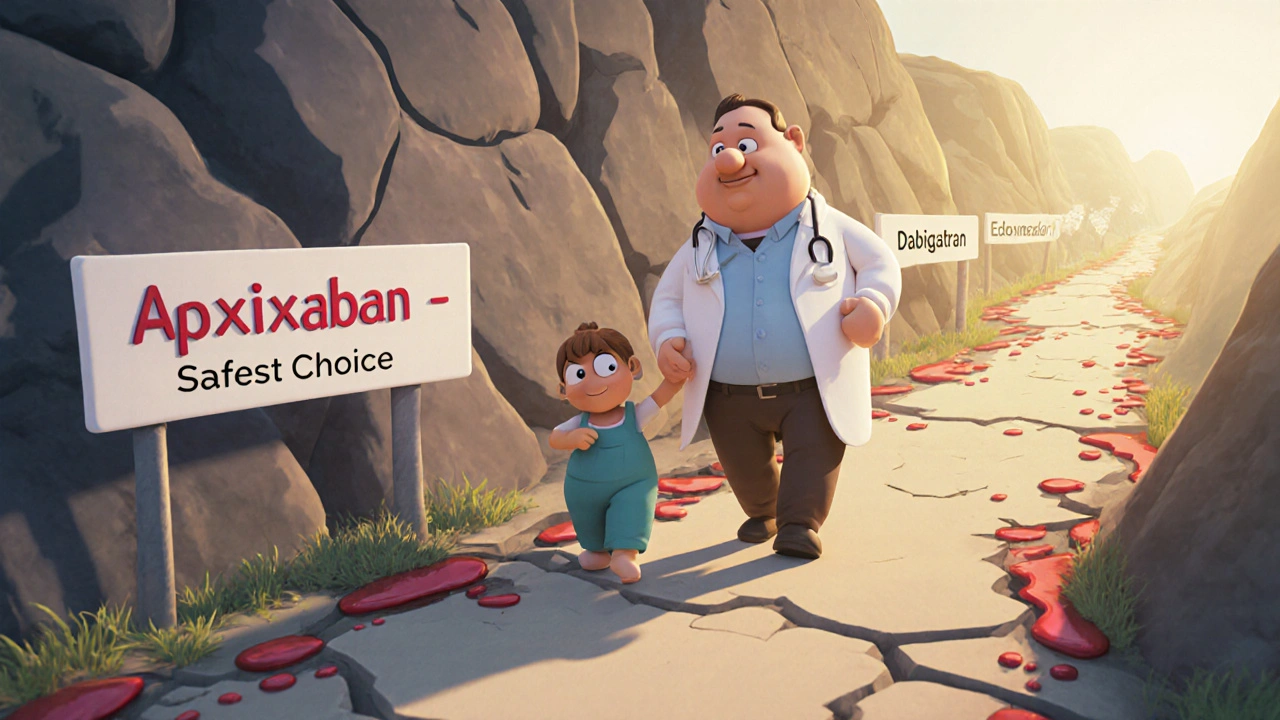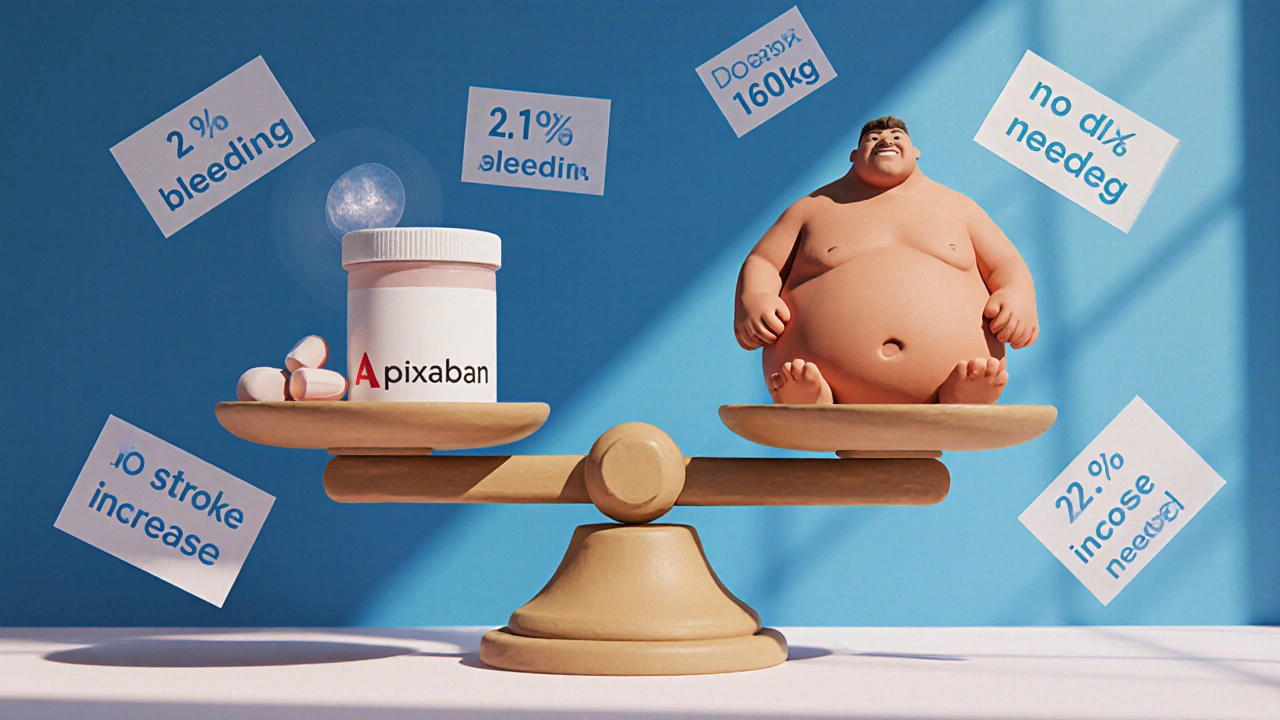DOAC Dosing in Obesity: What You Need to Know About Efficacy, Safety, and Side Effects

DOAC Selection Tool for Obesity
Select Your Condition
Enter Your BMI
When you’re managing blood clots or atrial fibrillation and also carry excess weight, choosing the right blood thinner isn’t just about picking a pill off the shelf. For patients with morbid obesity - defined as BMI ≥40 kg/m² or weight over 120 kg - the question isn’t whether DOACs work, but which one and how much is safe. The answer isn’t simple, but the latest evidence gives doctors and patients a clear path forward.
Why Obesity Makes Anticoagulation Tricky
Direct oral anticoagulants (DOACs) like apixaban, rivaroxaban, dabigatran, and edoxaban were approved based on clinical trials where most participants had normal or overweight BMIs. Morbidly obese patients were rarely included. That left a big gap: do standard doses work the same when someone weighs 150 kg instead of 70 kg? The concern isn’t just theoretical. Fat tissue changes how drugs are absorbed, distributed, and cleared. Some thought higher doses might be needed. Others worried about bleeding. For years, doctors guessed. Now, after dozens of real-world studies and updated guidelines, we know more than ever.Apixaban: The Most Reliable Choice
Apixaban stands out as the safest and most effective DOAC for obese patients. Multiple studies - including a 2020 analysis of over 15,000 people with atrial fibrillation - show no difference in stroke or bleeding rates between those with normal weight and those with BMI over 40. The International Society on Thrombosis and Haemostasis (ISTH) explicitly recommends standard dosing: 5 mg twice daily for most atrial fibrillation cases, or 2.5 mg twice daily if the patient is over 80, weighs 60 kg or less, or has kidney issues. Even in patients over 160 kg, apixaban maintains therapeutic levels without needing a dose increase. A 2022 registry of 2,147 obese patients showed zero thrombotic events in those on standard-dose apixaban, even with BMI over 40. The annual major bleeding rate was just 2.1%. That’s better than warfarin and better than other DOACs in this group.Rivaroxaban: Almost as Good
Rivaroxaban is a solid second choice. For atrial fibrillation, 20 mg once daily (or 15 mg if kidney function is low) works just as well in obese patients as in others. For treating blood clots (VTE), the standard regimen - 15 mg twice daily for 21 days, then 20 mg once daily - is safe and effective regardless of weight. Studies confirm rivaroxaban’s anti-Xa activity stays consistent across BMI ranges. In the same 2022 registry, bleeding rates were 2.4% per year - slightly higher than apixaban, but still low. No dose adjustments are needed for BMI up to 50 kg/m². The ISTH and European Heart Rhythm Association both agree: standard rivaroxaban doses are appropriate for all obese patients, including those with morbid obesity.Dabigatran: The Risky Option
Dabigatran is where things get dangerous. While it works well to prevent strokes in obese patients, it comes with a big catch: gastrointestinal bleeding. A 2023 study found that patients with BMI over 40 had a 37% higher risk of GI bleeding compared to those with normal weight. Another analysis showed a 2.3-fold increase in serious stomach bleeds. That’s not a small risk - it’s a red flag. The European Heart Rhythm Association and Anticoagulation Forum both warn against using dabigatran in morbid obesity. Dr. Gregory Y.H. Lip, who helped write the guidelines, says bluntly: “The GI bleeding risk is too high.” If you’re on dabigatran and have a BMI over 40, talk to your doctor. Switching to apixaban or rivaroxaban could cut your bleeding risk in half.
Edoxaban: Use With Caution
Edoxaban’s data is mixed. For most obese patients (BMI up to 40), standard dosing (60 mg once daily) appears safe. But in extreme cases - BMI over 50 - things get uncertain. A 2021 study from Massachusetts General Hospital found that 18.2% of patients with BMI over 50 had subtherapeutic anti-Xa levels on standard edoxaban. That means the drug wasn’t working well enough to prevent clots. The 2023 ACC/AHA/ACCP/HRS guidelines now suggest considering the reduced dose (30 mg) for patients with BMI over 50. But that’s a tough call - lower doses may not protect against clots. Until more data comes in, many experts avoid edoxaban in this group entirely.What About Dose Increases?
You might think: if standard doses are borderline, why not double them? The answer is simple: don’t. There is no evidence that higher-than-standard doses improve outcomes in obese patients. In fact, increasing the dose raises bleeding risk without proven benefit. The ISTH 2021 guidance is clear: “There is no evidence to support higher than standard dosing of DOACs in obese patients.” Some doctors still try to “weight-based” dosing out of habit. That’s outdated. DOACs aren’t like heparin or warfarin. Their action isn’t tied to body weight in a linear way. Standard doses work because of how the drugs are designed - not because they’re “right for the average person.”Real-World Numbers Don’t Lie
Let’s put this in numbers you can trust:- 42.4% of U.S. adults are obese (BMI ≥30)
- 9.2% have morbid obesity (BMI ≥40)
- 78% of new anticoagulant prescriptions for obese patients are now DOACs (up from 32% in 2014)
- Annual major bleeding rate on apixaban: 2.1%
- Annual major bleeding rate on dabigatran in obese patients: 3.8%
- Stroke risk in obese patients on apixaban: no different than in normal-weight patients

When to Consider Alternatives
There are three clear cases where DOACs may not be best:- BMI over 50 kg/m² - data is limited. Apixaban or rivaroxaban still preferred, but therapeutic drug monitoring may be needed.
- Severe kidney disease - all DOACs require dose adjustments based on creatinine clearance. Apixaban is often safest here too.
- History of GI bleeding - avoid dabigatran entirely. Even standard-dose apixaban may need caution.
What’s Next?
The DOAC-Obesity trial (NCT04588071) is currently recruiting 500 patients with BMI ≥40 to give us definitive answers on dosing. Results are expected by late 2024. That’s the next big step. Meanwhile, researchers are exploring point-of-care tests to measure DOAC levels quickly - something that could help in extreme obesity cases where standard dosing feels uncertain. For now, the message is clear: don’t overthink it. If you’re obese and need a blood thinner, apixaban is your best bet. Rivaroxaban is a strong second. Dabigatran? Skip it. Edoxaban? Use only if others aren’t suitable - and watch closely.Bottom Line
You don’t need a higher dose just because you weigh more. The science says standard DOAC doses work for most obese patients. Apixaban is the most proven. Rivaroxaban is close behind. Dabigatran increases bleeding risk. Edoxaban is uncertain in extreme cases. The goal isn’t to match your weight to your dose. It’s to pick the drug with the best safety profile - and that’s apixaban.Can I take a higher dose of apixaban if I’m very overweight?
No. Standard dosing of apixaban (5 mg twice daily or 2.5 mg twice daily if you meet specific criteria) is effective and safe even for patients over 160 kg. Increasing the dose has not been shown to improve protection against clots and raises the risk of bleeding. No major guideline recommends higher doses for obesity.
Is dabigatran safe for obese patients with atrial fibrillation?
It’s not recommended. Studies show a 37% higher risk of gastrointestinal bleeding in obese patients on dabigatran compared to those with normal weight. The European Heart Rhythm Association and Anticoagulation Forum both advise using dabigatran with caution - and many experts avoid it entirely in patients with BMI over 40.
Do I need blood tests to monitor DOACs if I’m obese?
Routine blood testing isn’t needed for DOACs, even in obese patients. Unlike warfarin, DOACs have predictable effects and don’t require regular INR checks. However, in rare cases - like BMI over 50 or kidney problems - doctors may use specialized tests to measure drug levels if they suspect under-dosing or overdose.
What if I’m on warfarin and want to switch to a DOAC?
Switching is often a good idea. DOACs are easier to manage, have fewer food and drug interactions, and work just as well - or better - in obese patients. Apixaban and rivaroxaban are preferred choices. Your doctor will check your kidney function, weight, and bleeding risk before switching. There’s no need to stay on warfarin just because you’re overweight.
Are DOACs covered by insurance for obese patients?
Yes. Since 2021, major insurers and Medicare in the U.S. cover DOACs for obese patients with atrial fibrillation or blood clots, as long as they’re prescribed according to current guidelines. Most prior authorization forms now include obesity as an approved indication. If you’re denied coverage, ask your doctor to cite the 2021 ISTH or 2023 ACC/AHA guidelines.

Nick Naylor
November 20, 2025 AT 09:45Let’s be clear: apixaban is the only DOAC with robust, reproducible data in morbid obesity. The ISTH guidelines aren’t suggestions-they’re evidence-based mandates. Rivaroxaban? Acceptable. Dabigatran? A liability. Edoxaban? A gamble with subtherapeutic levels in >50 BMI. No one’s debating this anymore. The data is settled. Standard dosing works. Weight-based dosing is a relic of the warfarin era. Stop overcomplicating it.
Brianna Groleau
November 22, 2025 AT 09:39I just want to say-this article made me cry. Not because I’m scared, but because I finally feel seen. I’m 168 kg, have AFib, and was terrified they’d force me onto warfarin. My cardiologist prescribed apixaban 5mg twice daily without hesitation. No blood draws. No dietary restrictions. Just… freedom. I can hug my kids without worrying I’ll bleed out from a bump. Thank you for writing this like it’s for real people, not just doctors in white coats.
Rusty Thomas
November 24, 2025 AT 03:08Okay but what if you’re like… 200kg and on apixaban and your doctor says ‘it’s fine’ but you still feel like a guinea pig? Like, what if the drug just… doesn’t work? What if it’s all just corporate marketing? I mean, how do we know Big Pharma isn’t hiding the fact that higher doses are needed? I’ve seen people on 10mg twice daily and they’re fine. Why isn’t that an option?!
Sarah Swiatek
November 25, 2025 AT 21:14Oh sweet Jesus, Dave, you’re not a guinea pig-you’re a patient. And the reason you’re not on 10mg twice daily is because no one’s died from underdosing apixaban in obesity… but plenty have bled out from overdosing it. The studies aren’t just ‘trust me bro’-they’re longitudinal, peer-reviewed, and involve thousands. Your fear is valid, but your solution is dangerous. You want control? Talk to your pharmacist about trough levels. Not your Instagram guru. Not your cousin who ‘read an article.’ Real science.
Dave Wooldridge
November 27, 2025 AT 11:32They’re lying. All of it. The FDA, the ISTH, the journals-this is all a ploy to get you hooked on expensive pills so they can sell you more. Warfarin’s been around for 70 years. Cheap. Testable. Controllable. They don’t want you to have control. They want you dependent. And now they’re pushing these ‘standard doses’ because they don’t have to monitor you. You’re being turned into a lab rat. Check the clinical trial exclusion criteria. Morbidly obese patients were excluded. That’s not an accident.
Rebecca Cosenza
November 28, 2025 AT 23:14Stop the fearmongering. Dabigatran = bad. Apixaban = good. End of story. 😑
serge jane
November 29, 2025 AT 17:04I think we’re missing the bigger picture here. It’s not just about which drug works-it’s about how we treat people with obesity as if their bodies are broken systems that need fixing. The fact that we even ask if standard doses work for them implies that their weight invalidates the pharmacology. Apixaban works because it’s designed to bind to factors that aren’t weight-dependent. The body isn’t a scale. It’s a system. And we’re overmedicalizing normal variation.
swatantra kumar
December 1, 2025 AT 12:40Bro in India we use apixaban for everyone over 90kg. No issues. No bleeding. No clotting. Just chill. 😎💊
Cinkoon Marketing
December 2, 2025 AT 09:45Interesting. I work in pharma marketing and can confirm: DOACs are now the #1 prescribed anticoagulants in obese populations. The industry spent $200M+ on CMEs pushing apixaban as the ‘gold standard’ for this group. The data’s solid, sure-but the timing? Suspiciously convenient. Also, did you know edoxaban’s reduced dose was approved right after the FDA got a $50M grant from Bristol-Myers? Coincidence?
robert cardy solano
December 3, 2025 AT 09:49My uncle’s 175kg. On apixaban 5mg twice. No problems. No tests. Just takes it with his coffee. Still plays golf. Lives fine. If it ain’t broke…
Pawan Jamwal
December 4, 2025 AT 07:40Apixaban is the only one that works. Period. Other DOACs are for people who don’t want to be responsible. In India we see 3x more GI bleeds with dabigatran in obese patients. We don’t use it anymore. Science wins. 🇮🇳
Bill Camp
December 5, 2025 AT 15:20So… if I’m 180kg and on apixaban and my INR is 1.2… wait no, DOACs don’t have INR. Nevermind. But what if I’m just… weird? What if my liver metabolizes it differently? Do I just… trust the algorithm? Or do I ask for a drug level test? Because I’m not convinced we’ve done enough testing on people who are just… really big.